Revolution of Printing

Working Replica of Gutenberg's Printing Press
Johann Gutenberg of Mainz, Germany is credited with developing the printing press with movable type, the greatest invention of the past millennium.
The printing press in the Ink & Blood exhibit brings forward a more recent theory on how Gutenberg first printed. There are no descriptions, diagrams or drawings of any kind depicting printing before the year 1500. Most depictions are actually images of a 16th century press or later. What is presented in Ink & Blood is the theory that Gutenberg took an existing 15th century German wine press and converted it to the first printing press with movable type in the West. The Ink & Blood press actually pressed grapes before it was converted to print. On display this printing press is operated in live demonstrations.
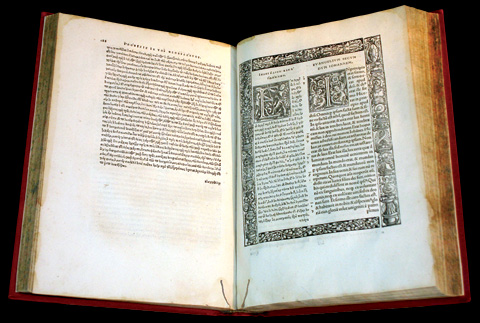
Novum Instrumentum (New Instrument)
Novum Instrumentum (New Instrument)
Erasmus’s Greek-Latin New Testament
Desiderius Erasmus, 1466-1536
1522
Third Edition
Basle, Switzerland
Printed on paper and illustrated with printed woodcut capital letters and borders. The 1516 first edition was the first published Greek New Testament and the return of Greek to the West for the first time in over a thousand years. The 1519 second edition was used by Martin Luther to translate the New Testament from Greek into German for the first time. The 1522 third edition was used by William Tyndale to translate the New Testament from Greek into modern English for the first time. Erasmus’s text became the foundation for the Textus Receptus.

Obedience of a Christian Man
Obedience of a Christian Man
William Tyndale, 1449-1536
1528
First edition
Antwerp, Belgium
This book is Tyndale’s treatise on theology.
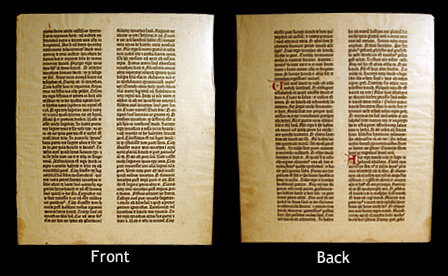
Gutenberg Bible Leaf (2)
Gutenberg Bible Leaf (2)
Printed by Johann Gutenberg, c.1397-1468
1453-1455
Mainz, Germany
From the large format Latin Bible and famed for being the earliest printed work in the West, Gutenberg’s massive two volume Latin Bible, with a total of 1282 pages, was all but unknown until a copy was discovered in the library of Cardinal Jules Mazarine in 1760, hence it is often called the Mazarine Bible. Bibliographers will often refer to it as the 42 line Bible. Darlow and Moule note, “It is probably the first large book, if not the first considerable piece of printing executed in Europe with movable metal types.” For this Bible Gutenberg cast 290 different shapes. An illuminator and a columnist added the beautiful colorful initials and artwork later. In 1452, Gutenberg borrowed money to buy the 100,000 sheets of paper and 8,000 skins needed to print the 180 copies of this Bible. It is believed that 150 were printed on paper and 30 were printed on exquisite parchment. Forty-eight known complete or near complete copies remain in existence.
Ink & Blood displays two leaves from a Gutenberg Bible.
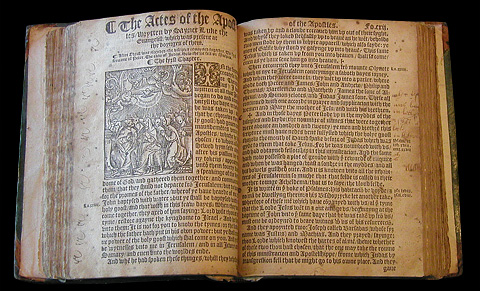
William Tyndale New Testament
William Tyndale New Testament
William Tyndale New Testament
William Tyndale New Testament
Tyndale New Testament
William Tyndale, 1494-1536
1536
Antwerp, Belgium
In 1526, Tyndale translated Erasmus’s third edition Greek New Testament into the first English New Testament from the original language. It is believed that 3,000 copies were printed, but only three copies have survived – one lacking only the title leaf is owned by the British Library; a complete copy including the title page was discovered in the 1990’s in the Bibelsammlung at the Wuerttembergische Landesbibliothek in Stuttgart, Germany; and the copy in St. Paul’s in London that lacks 71 pages.
The 1536 Tyndale New Testament is the same wording and style of Tyndale’s 1534 revision of his 1526 New Testament. However, there were three distinct quarto editions published in 1536 identifiable by three variations in a woodcut of St. Paul. The foot of the Apostle rests on a stone, which is blank in one edition. In another, it bears the figure of a mole or hedgehog, and in the third there is an engravers mark with the initials A.K.B. On display is the Blank Stone edition.
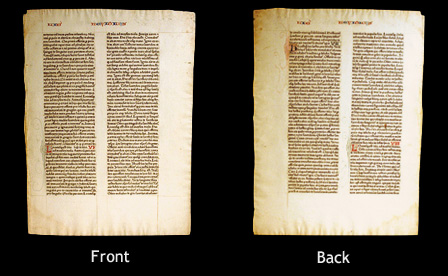
Fust & Schoeffer Bible Leaf (4)
Fust & Schoeffer Bible Leaf (4)
Printed by Johann Fust (c. 1400-1466), originally Gutenberg’s partner, and Fust’s new partner
Peter Schoeffer (1425-1503)
1462
Mainz, Germany
The Fust and Schoeffer Bible is a smaller version of the Gutenberg Bible. It was the first Bible to leave Germany to be rubricated and illuminated in England.
Ink & Blood displays four leaves from the Fust & Schoeffer Bible.
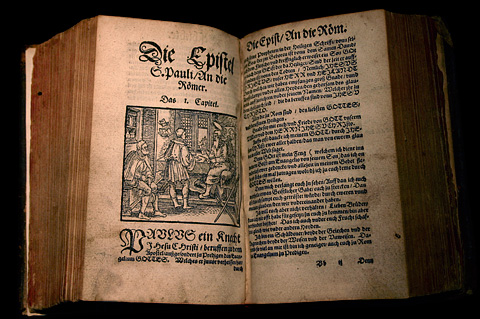
Luther New Testament
Luther New Testament
Martin Luther, 1483-1546
1551
Germany
Luther’s first edition of the New Testament is called the Septemberbibel or September New Testament because it was published September 21, 1522. The Luther New Testament shown is believed to be a rare first reprinting of Luther’s September New Testament. It is not listed in Darlow and Moule’s Historical Catalogue of the Printed Editions of Holy Scripture, and today only two copies are known to have survived, the one currently on display with Ink & Blood and another at Cambridge University.
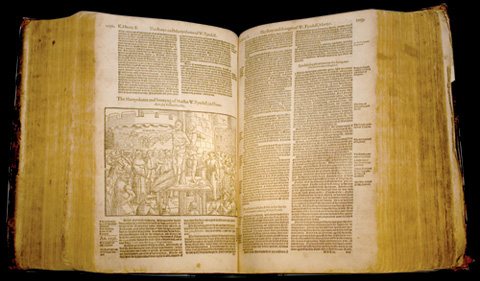
The Ecclesiastical History Concerning the Acts and Monuments of Martyrs
The Ecclesiastical History Concerning the Acts and Monuments of Martyrs
John Foxe, 1516-1587
1576
Third edition
London, England
This famous sixteenth-century text is a history of the English Reformation with the intent to praise the Protestant martyrs of Queen Mary I (r.1553-1558).
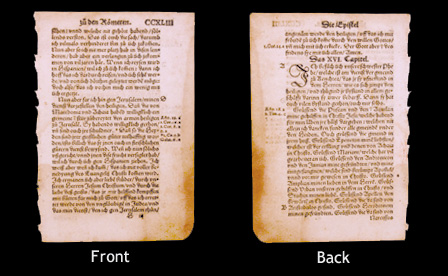
Luther New Testament Leaf
Luther New Testament Leaf
Martin Luther, 1483-1546
1526-1529
Germany
